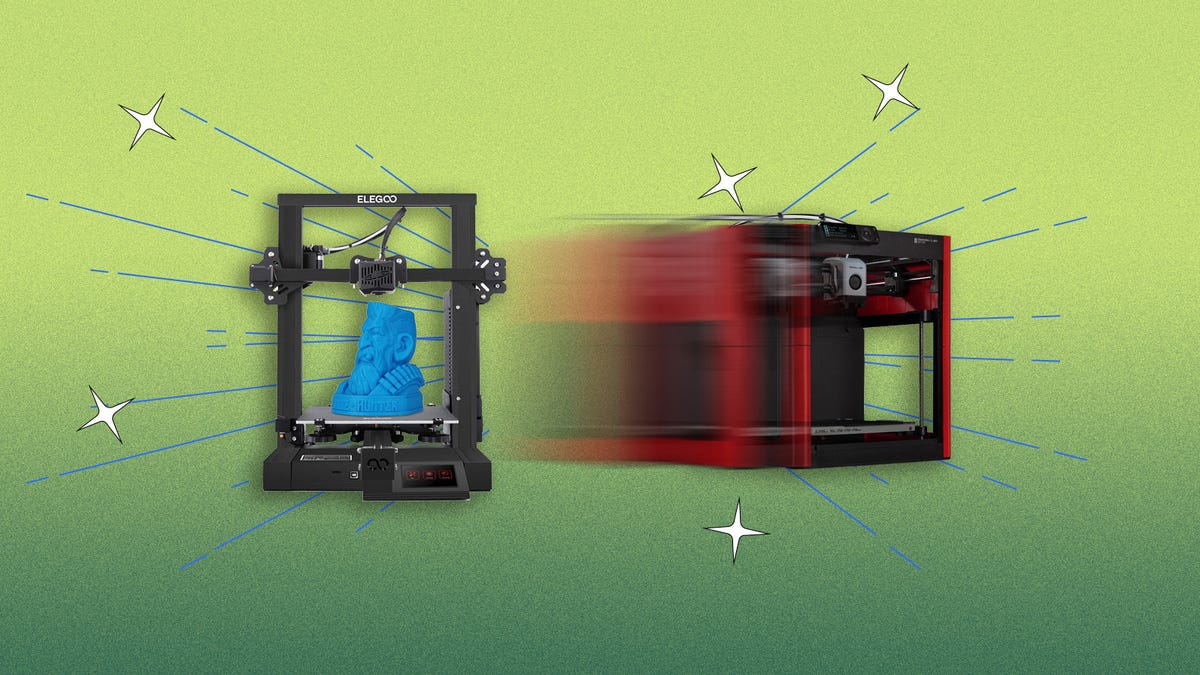 Why You Can Trust CNET
Why You Can Trust CNET Should You Upgrade Your 3D Printer to a Faster One? Not So Fast
Ultra-fast 3D printers are here, but you don't need to upgrade straight away.

One thing most 3D printer hobbyists need is patience. Patience in setting up and calibrating their machines, patience in finding or creating the perfect 3D models and most of all, patience in waiting for their creations to be painstakingly assembled line by line from plastic filament laid down at a crawl. That last part, however, doesn't necessarily need to take quite as long.
Here's what happened to change how we think about the speed of 3D printing.
The 3D printing business has been a race to the bottom in the last five years, price-wise. The need to create a class of budget 3D printers that still have some advanced features has consumed most manufacturers' attention. Elegoo, Anycubic, Creality and others have made the same type of printer with minor tweaks to improve operability. Meanwhile, big-name brands like Prusa, Ultimaker, and Raise3D have iterated on their tried and tested machines, focusing on the quality of the print rather than the speed.
Read more: Best 3D Printer for 2023
All that changed in early 2023 with the release of the AnkerMake M5, followed closely by the Bambu Lab X1 Carbon. Overnight, 3D printing had machines that printed stunning models at least twice as fast as other printers. The speed race was on, and other companies started to respond in earnest. Prusa now has the MK4, Creality has the K1 and other companies are sure to follow suit. If you are new to 3D printing and are looking to start, then buying one of these super-fast machines will be a boost to your hobby, if you have the budget for it.
The big question, though: If you already have a 3D printer that works for you, should you rush out to buy a new, faster machine?
The answer: It really depends on your current machine
The decision to upgrade will likely come down to one of three factors
- Do you need to print faster? (for example, if you print professionally)
- Your budgetary needs (faster printers are more expensive)
- Your current 3D printer's quality is fine (if it ain't broke…)
Your budget
These ultra-fast 3D printers start at around $600 – the Creality K1 and the Bambu Lab P1P being the cheapest ultra-fast machines – but can go as high as $1,400 for the Bambu Lab X1 Carbon. If your current machine is a budget 3D printer like the Elegoo Neptune 3 ($229) then spending three times as much to upgrade is daunting. You could simply buy another Neptune 3 and print twice as many things for around 200 bucks.
Business needs
3D printing has always been great for rapid prototyping. If you run a small business or are an at-home inventor, having a machine that can print your ideas and allow you to improve on them is invaluable. Ultra-fast 3D printing makes rapid prototyping makes everything even more, well, rapid. A model that used to take four hours to print might take closer to 90 minutes with a machine like the Bambu Lab P1P. In the world of invention and small business, knocking nearly three-quarters of your time off a project is a huge deal.
I run an Etsy store for 3D printing, and while I have several standard-speed printers dedicated to the store, having faster machines obviously increases my output and therefore my profitability. If you are a believer in the adage "time is money," then investing in an ultra-fast 3D printer is a good idea.
Your quality
Without exception, all of the ultra-fast printers I've tested have produced results comparable to the very best 3D printers available. But if you already have your 3D printer dialed in to produce amazing results every single time, and neither of the other two points above applies to you, then maybe you just don't need to upgrade at all. After all, if you don't want to spend the money, don't need the speed for business and do have a printer that already gives fantastic results, the upgrade has no real purpose.
Print quality can be amazing on these ultra-fast printers
Should you buy a fast printer as your first printer?
3D printing is still an industry that's ruled by quality, so while speed is amazing to have, it might not be a reason to upgrade all on its own. If you're looking to buy your first 3D printer, though, and your budget allows it, you should absolutely be looking at one of these ultra-fast printers. The quality of the print, the quality of the machine, the ease of setup and the speed at which they print make them the best choice for a newcomer. My current suggestion is the Bambu Lab P1P. It ticks all of the boxes for an ultra-fast printer, and it does it at a middle-level price point of $699.
I've been using and testing 3D printers for nearly a decade, and I've seen a lot of exciting improvements. The advent of speed is just the next exciting move forward. It's always important to remember that new improvements don't invalidate the current crop. If your 3D printer still works well, keep it until it doesn't.

